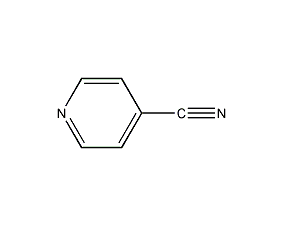4-Cyanopyridine 4-Cyanopyridine


Structural formula
| Business number | 02J1 |
|---|---|
| Molecular formula | C6H4N2 |
| Molecular weight | 104.11 |
| label |
4-cyanopyridine, 4-pyridinecarbonitrile, Pyridine-4-nitrile, Isonicotinic acid nitrile, Isoniazonitrile, 4-cyanonicotine, Isonicotine nitrile, Isonicotinic Acid Nitrile, Isonicotinonitrile, Akos Bbs-00004486, 4-Pyridinecarbonitrile, 4-Cyanopyridine, Timtec-Bb Sbb008923, Specs Ac-907/25014099, 4-Pyridinenitrile |
Numbering system
CAS number:100-48-1
MDL number:MFCD00006417
EINECS number:202-856-2
RTECS number:None
BRN number:107712
PubChem ID:None
Physical property data
1. Properties: White to light yellow needle-like crystals with a characteristic odor.
2. Density (g/mL, 20℃): Undetermined
3. Relative vapor density (g/mL, air=1): Undetermined
4. Melting point (ºC): 88
5. Boiling point (ºC, normal pressure): 196
6. Boiling point (ºC, 0.7mmHg): Undetermined
7. Refractive index: Undetermined
8. Flash point (ºC): 77-81
9. Specific rotation (º): Undetermined
10. Autoignition point or ignition temperature (ºC): Not determined
11. Vapor pressure (mmHg, ºC): Not determined
12. Saturated vapor pressure ( kPa, ºC): Undetermined
13. Heat of combustion (KJ/mol): Undetermined
14. Critical temperature (ºC): Undetermined
15. Critical pressure (KPa): Undetermined
16. Log value of oil-water (octanol/water) distribution coefficient: Undetermined
17. Explosion upper limit (%, V/ V): Undetermined
18. Lower explosion limit (%, V/V): Undetermined
19. Solubility: Soluble in ethanol, ether and benzene.
Toxicological data
1. Acute toxicity: Rat oral LD5O: 710mg/kg
Rabbit transdermal LD5O: >20g/kg
Ecological Mathematics�
This substance is slightly hazardous to water.
Molecular structure data
1. Molar refractive index: 29.11
2. Molar volume (cm3/mol): 92.8
3. Isotonic specific volume (90.2K ): 248.5
4. Surface tension (dyne/cm): 51.4
5. Dielectric constant:
6. Dipole moment (10-24cm3):
7. Polarizability: 11.54
Compute chemical data
1. Reference value for hydrophobic parameter calculation (XlogP): None
2. Number of hydrogen bond donors: 0
3. Number of hydrogen bond acceptors: 2
4. Number of rotatable chemical bonds: 0
5. Number of tautomers: none
6. Topological molecule polar surface area 36.7
7. Number of heavy atoms: 8
8. Surface charge: 0
9. Complexity: 105
10. Number of isotope atoms: 0
11. Determine the number of atomic stereocenters: 0
12. Uncertain number of atomic stereocenters: 0
13. Determine the number of chemical bond stereocenters: 0
14. Number of uncertain chemical bond stereocenters: 0
15. Number of covalent bond units: 1
Properties and stability
Avoid contact with oxidizing agents.
Storage method
Store in a cool, ventilated warehouse. Keep away from fire and heat sources. should be kept away from oxidizer, do not store together. Keep sealed. Use explosion-proof lighting and ventilation facilities. It is prohibited to use mechanical equipment and tools that are prone to sparks. The storage area should be equipped with emergency release equipment and suitable containment materials.
Synthesis method
None yet
Purpose
The main uses are pharmaceutical and pesticide intermediate products.
